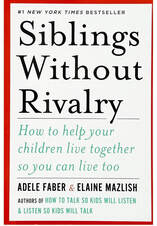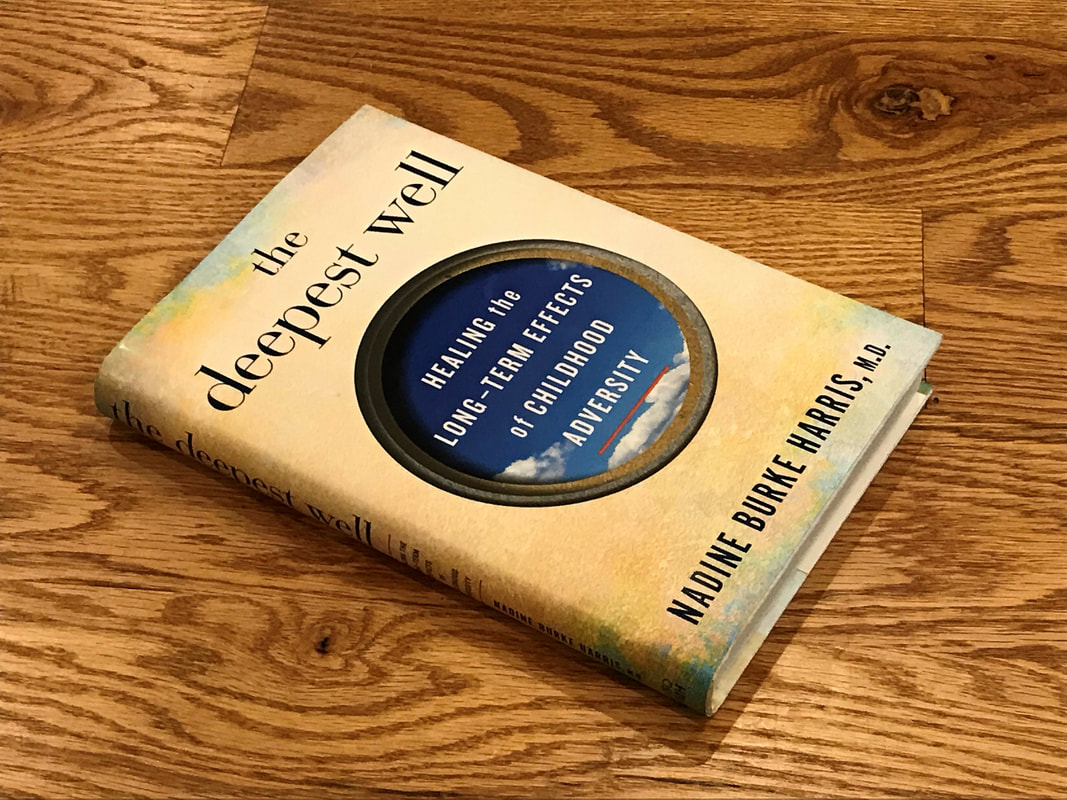The book is structured from the point of view of the author leading a support group of parents who are there to talk about the issues they are having with their children. Each class sets out to talk about a different subject, such as comparison of siblings, fighting between siblings, jealousy, etc. As the class progresses the author allows the parents to sometimes lead the subject into areas she hadn’t intended, but that are sometimes even more meaningful.
The subject of siblings does relate to childhood trauma in that sometimes a parent can create such animosity between children, or toward one child, that it really becomes a form of emotional abuse. In years past this probably wouldn’t have been recognized. There are many adults today who have suffered from a parent’s preference of one child over another. These wounds can be deep and can affect adult relationships. Some of the takeaways I gleaned from this book include the fact that parents can use comparisons in two ways. She can either praise one child to make the other child feel bad – usually trying to motivate the child to do better. Or a parent can put down one child while trying to make the other child feel better about himself. In either case, both children will suffer. The praised child suffers just as much as the put down child because comparison will destroy the potential joy of the sibling relationship. It will cause resentment among siblings that may last into adulthood. It is possible to motivate our children and to praise our children while treating them as an individual, not in comparison to someone else. There are many other subjects discussed, such as whether it’s necessary to always give every child the same things – it’s not, and how to handle frequent fighting – teach them to work it out themselves in a safe way. It also mentioned the affect that a sibling with special needs can have on the family and explored the best ways to include that child without having a negative effect on the siblings. In all, it was a very helpful book for parents. However, it could also be a helpful book for any adult who has had a difficult relationship with a sibling or parent. Many of these issues were explored in an easy-to-read way. If you are like me and don’t have time to read, you can also check out the audio book! Happy reading! Laura Shamblin, MD
0 Comments
On Friday April 26th, I had the privilege of attending the Resilient Payne County Next Steps Conference. Community advocates from all over the state of Oklahoma attended and spent time learning from each other what is being done in their communities to foster resilience and combat adverse childhood events. The conference was planned and executed by the fearless Dr. Carolynn MacAllister, retired professor of OSU Veterinary Clinical Sciences. She is a community advocate for Stillwater and the state of Oklahoma, and has been instrumental in passing bills such as the one that formed the Trauma Informed Task Force for the the State of Oklahoma. She had help with the conference from the Potts Family Foundation, which remains dedicated to fostering programs that promote early childhood safety and education. I was able to talk with attendees and pass out flyers for Trauma Informed MD, and since then there has been an increase in website traffic which should mean that more Oklahoma communities are becoming aware of the resources available at TraumaInformedMD.com.
On Thursday May 2nd, I had the privilege of spending an hour talking to the therapists at SoonerStart of Oklahoma County about Trauma and Resilience. SoonerStart is a publicly funded program that provides therapy services such as Speech Therapy, Occupational and Physical Therapy to children ages 0-3 who have been identified as having a developmental delay in one of these areas. By providing early intervention we can make it more likely that these children will catch up and succeed in school. Since many of the studied interventions for preventing ACEs have been supporting parents of young children with home visits by trained professionals, it is intuitive that these therapists are poised to provide support to parents, since they are already doing home visits. If we can provide training and resources to these therapists, they will be able to pass on that information to parents who may be struggling. I look forward to more training opportunities such as this with our excellent professionals providing services to children in our state. Now I am putting together a 2-3 hour training for Foster Parents who will be attending one of several free trainings put on by the Oklahoma Baptist Homes for Children One Such Child initiative this summer. OBHC provides free training while the children have fun attending a Vacation Bible School event. I'll be speaking June 5th at Eastwood Baptist Church in Midwest City, and June 14th at Capitol Hill Baptist Church as part of these trainings. If you are a Foster Parent and are interested in finding a training near you please go to https://www.obhc.org/FosterParentTraining. Blessings, Laura Shamblin, MD For an introduction to the science of childhood adversity there really is not a better book out there than The Deepest Well by Nadine Burke Harris, MD. The title comes from the public health story of John Snow tracing the source of a massive cholera outbreak to a community well in London of 1854. This was a breakthrough, as previously cholera was assumed to be spread by foul air. This physician, through applying a systematic approach was able to narrow the source of a public health crisis down to a water source. In the same way childhood adversity has been the secret source of most of our public health problems. From obesity to illicit drug use, from heart attacks and strokes to suicide, childhood adversity plays a larger role than we have ever realized. And when we try to shout it from the mountain-tops we can expect some push-back and skepticism, as when any new concept is brought forward.
Dr. Burke Harris uses a skillful and engaging combination of explaining the science through the stories of discovery, case stories of actual patients she has treated, and anecdotes about family and friends to illustrate the different concepts that need to be understood. Concepts like nature vs. nurture, epigenetics, universal screening, the buffering that caregivers provide, and the physical reactions of the body to toxic stress and childhood adversity. This book is an easy and accessible read for anyone, while also being a foundational text for primary care physicians to understand the importance of considering childhood adversity and the positive results we can expect if we apply universal screening for ACEs (Adverse Childhood Experiences) in our practices. The Healthcare page of TraumaInformedMD.com has a section of links to available screening tools that have been standardized for use in primary care, including Dr. Burke Harris’s. There is also a link to the National Pediatric Practice Community on ACEs which was organized by the non-profit she founded. My favorite part of the book is a small section towards the end where she talks about how children who have grown up as survivors of childhood adversity often develop mini-superpowers. She describes her own ability to stay calm and follow protocols in a life-threatening situation. Some survivors develop an increased ability to be attuned to others, to read nonverbal cues and faces. Some become able to charm others in order to get their needs met, and some develop empathy and compassion for the vulnerable. People in serving professions often come from a background of adversity; they have overcome to use their special abilities to help others. This is my favorite concept. I appreciate the author’s ability to take difficult concepts and make them interesting and easy to understand. I also appreciate her transparency as this is a memoir of sorts. She shares some very painful times in her life with the hope of helping others understand that adversity is something we all face at one time or another. It is not an issue of social class. Only universal screening and awareness would allow us to protect and treat all children. And aren’t they all worthy of protection and healing? Laura Shamblin, MD www.TraumaInformedMD.com This week I was able to attend the Faith Communities Protecting Children conference in Oklahoma City put on by the Potts Family Foundation, the Interfaith Alliance, and the Center for Child Abuse and Neglect at OU. The keynote speaker was Dr. Darrell L. Armstrong the Pastor of Shiloh Baptist Church in Princeton, NJ and founder of the Institute for Clergy Training. He is the product of the Resilience that is offered by faith in Jesus Christ and the support of his local church in South L.A. while he was in foster care as the child of a teen mom. He went on to attend Stanford University and Princeton Theological Seminary and to be a strong advocate for the role Faith communities can have in protecting and supporting vulnerable children and families. I wanted to let you know I have added 5 new links of National Resources to the Churches page of the site. These look like great new resources to share with your local pastors and clergy. Please check them out and share!
Recently, I was privileged to attend the American Academy of Pediatrics - Trauma Informed Pediatric Provider Course in San Antonio, Texas where leaders in trauma treatment from around the U.S. came together to share information and updates in the field. While there I got a sneak preview of this screening tool which is now being released for free from Utah's Trauma-Resiliency Collaborative. It was developed to be used in healthcare clinics but could also be used in many other situations such as therapy, counseling, intake at shelters or resource centers, etc. It is currently being used and information gathered for the validation process. If you'd like to participate, you can follow the instructions to use it in your setting and return filled out screens to the TRC. There are instructions for follow up with PTSD screens or depression screens when indicated. This screen has been shown to show sources of distress that may be missed on a depression screen alone. I hope it is a blessing to many.
Link to article explaining development of HRSQ Link to HRSQ screen with instructions |
Laura Shamblin, MDEditor-in-chief of TraumaInformedMD.com Archives
April 2022
Categories |






 RSS Feed
RSS Feed